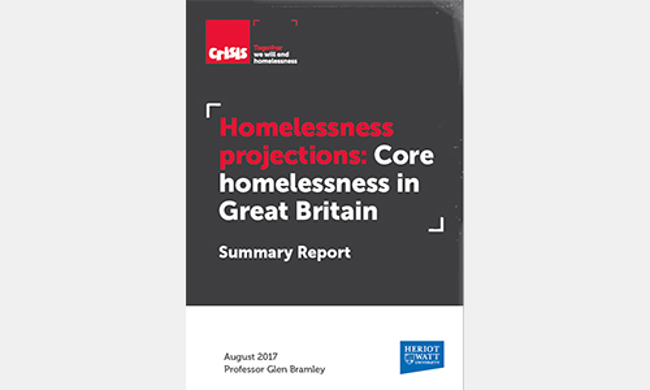Homelessness projections: Core homelessness in Great Britain (2017)
10.08.2017
This summary report is the first part of a two-part study examining the current and projected levels of different categories of homelessness, defined as ‘core’ and ‘wider’ homelessness. The figures set out in this report examine current levels of core homelessness across England, Scotland and Wales, their projected levels until 2041, factors driving these and the potential impact of policy measures to address the issue.
Key findings
- At any one point in time, core homelessness in 2016 stood at around 160,000 households in Great Britain (143,000 in England, 5,100 in Wales, 11,800 in Scotland)
- Many of these households are single adults of working age, but there is a significant number of families and children within some of these groups. We estimate that core homelessness contains 57,000 ‘family’ households (couples or lone parents) containing 82,000 adults and 50,000 children, so that the core homeless ‘population’ is 236,000.
- Based on the model, the level of core homelessness in Great Britain is predicted to continue to rise in the medium term, with the possibility of a slight levelling off of the rate of increase in the short term due to housing market corrections and a favourable labour market.
- In the longer term it is likely that numbers would increase further, particularly in London, with greater use of unsuitable temporary accommodation as well as rough sleeping and sofa-surfing.
- Looking at England, Scotland and Wales there is a remarkable degree of difference between the future scale and shape of core homelessness in the three countries:
- England shows an initial pause followed by an accelerating increase, which is most dramatic at the end of the forecast period.
- Wales shows a sharper initial increase, with a pause after 2021, then a further medium rate of increase.
- Scotland by contrast shows an initial downward trajectory until 2016, then a gradual increase, to the end of the period.
- The most important driver of homelessness in all its forms is poverty, which features strongly in all of the statistical models. Other drivers include, availability and affordability of accommodation, the extent to which prevention measures are used and the demographics of people experiencing homelessness.
- Using a series of ‘what if’ scenarios the model has shown is that cessation of welfare cuts and focused prevention activity can make an impact on levels of core homelessness but this is limited if not accompanied by investment in affordable and accessible housing supply.
Reference
Bramley, G. (2017) Homelessness projections: Core homelessness in Great Britain, London: Crisis.

